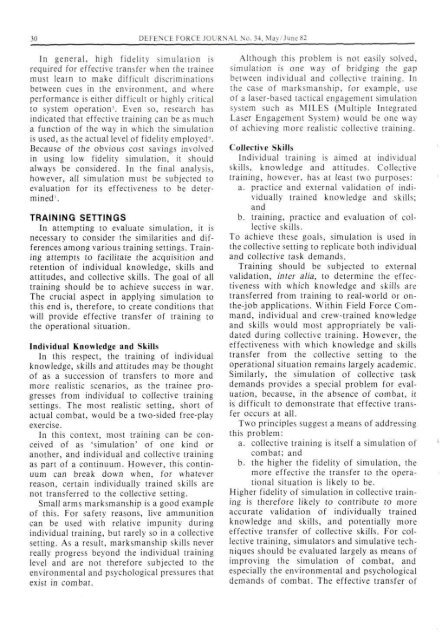ISSUE 34 : May/Jun - 1982 - Australian Defence Force Journal
ISSUE 34 : May/Jun - 1982 - Australian Defence Force Journal
ISSUE 34 : May/Jun - 1982 - Australian Defence Force Journal
You also want an ePaper? Increase the reach of your titles
YUMPU automatically turns print PDFs into web optimized ePapers that Google loves.
30 Dtl-hNCL f-ORC'I lOL'RN'AL No. <strong>34</strong>, Ma> Iune82<br />
In general, high fidelity simulation is<br />
required for effective transfer when the trainee<br />
must leain to make difficult discriminations<br />
between cues in the environment, and where<br />
performance is either difficult or highly critical<br />
to system operation'. Even so, research has<br />
indicated that effective training can be as much<br />
a function of the way in which the simulation<br />
is used, as the actual level of fidelity employed".<br />
Because of the obvious cost savings involved<br />
in using low fidelity simulation, it should<br />
always be considered. In the final analysis,<br />
however, all simulation must be subjected to<br />
evaluation for its effectiveness to be determined'.<br />
TRAINING SETTINGS<br />
In attempting to evaluate simulation, it is<br />
necessary to consider the similarities and differences<br />
among various training settings. Training<br />
attempts to facilitate the acquisition and<br />
retention of individual knowledge, skills and<br />
attitudes, and collective skills. The goal of all<br />
training should be to achieve success in war.<br />
The crucial aspect in applying simulation to<br />
this end is, therefore, to create conditions that<br />
will provide effective transfer of training to<br />
the operational situation.<br />
Individual Knowledge and Skills<br />
In this respect, the training of individual<br />
knowledge, skills and attitudes may be thought<br />
of as a succession of transfers to more and<br />
more realistic scenarios, as the trainee progresses<br />
from individual to collective training<br />
settings. The most realistic setting, short of<br />
actual combat, would be a two-sided free-play<br />
exercise.<br />
In this context, most training can be conceived<br />
of as 'simulation' of one kind or<br />
another, and individual and collective training<br />
as part of a continuum. However, this continuum<br />
can break down when, for whatever<br />
reason, certain individually trained skills are<br />
not transferred to the collective setting.<br />
Small arms marksmanship is a good example<br />
of this. For safety reasons, live ammunition<br />
can be used with relative impunity during<br />
individual training, but rarely so in a collective<br />
setting. As a result, marksmanship skills never<br />
really progress beyond the individual training<br />
level and are not therefore subjected to the<br />
environmental and psychological pressures that<br />
exist in combat.<br />
Although this problem is not easily solved,<br />
simulation is one way of bridging the gap<br />
between individual and collective training. In<br />
the case of marksmanship, for example, use<br />
of a laser-based tactical engagement simulation<br />
system such as MILES (Multiple Integrated<br />
Laser Engagement System) would be one way<br />
of achieving more realistic collective training.<br />
Collective Skills<br />
Individual training is aimed at individual<br />
skills, knowledge and attitudes. Collective<br />
training, however, has at least two purposes:<br />
a. practice and external validation of individually<br />
trained knowledge and skills;<br />
and<br />
b. training, practice and evaluation of collective<br />
skills.<br />
To achieve these goals, simulation is used in<br />
the collective setting to replicate both individual<br />
and collective task demands.<br />
Training should be subjected to external<br />
validation, inter alia, to determine the effectiveness<br />
with which knowledge and skills are<br />
transferred from training to real-world or onthe-job<br />
applications. Within Field <strong>Force</strong> Command,<br />
individual and crew-trained knowledge<br />
and skills would most appropriately be validated<br />
during collective training. However, the<br />
effectiveness with which knowledge and skills<br />
transfer from the collective setting to the<br />
operational situation remains largely academic.<br />
Similarly, the simulation of collective task<br />
demands provides a special problem for evaluation,<br />
because, in the absence of combat, it<br />
is difficult to demonstrate that effective transfer<br />
occurs at all.<br />
Two principles suggest a means of addressing<br />
this problem:<br />
a. collective training is itself a simulation of<br />
combat; and<br />
b. the higher the fidelity of simulation, the<br />
more effective the transfer to the operational<br />
situation is likely to be.<br />
Higher fidelity of simulation in collective training<br />
is therefore likely to contribute to more<br />
accurate validation of individually trained<br />
knowledge and skills, and potentially more<br />
effective transfer of collective skills. For collective<br />
training, simulators and simulative techniques<br />
should be evaluated largely as means of<br />
improving the simulation of combat, and<br />
especially the environmental and psychological<br />
demands of combat. The effective transfer of

















